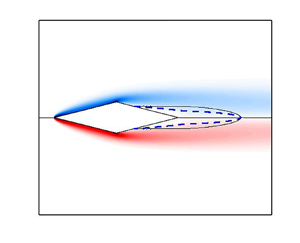Published online by Cambridge University Press: 15 February 2022

A scaling law to predict the onset of the primary Hopf instability in the steady flow past two-dimensional symmetric bluff bodies is proposed. It uses a measure of the spatial extent of the separation bubble as the length scale and the largest reverse-flow speed within it as the velocity scale. The ensuing Reynolds number, evaluated at the onset of the primary Hopf bifurcation, collapses quite nicely for bodies of different shape and aspect ratio even when a small angle of attack perturbs the symmetry; its relative variation is one order of magnitude smaller than that of the usual Reynolds number defined with the free-stream velocity and the cross-stream body size. With the new scaling, it can be roughly assessed whether the steady flow past a two-dimensional bluff body is absolutely and globally unstable to two-dimensional perturbations without a computationally expensive stability analysis: only the inspection of the base flow is required. More importantly, the scaling provides an insight into the flow mechanism that produces the instability.